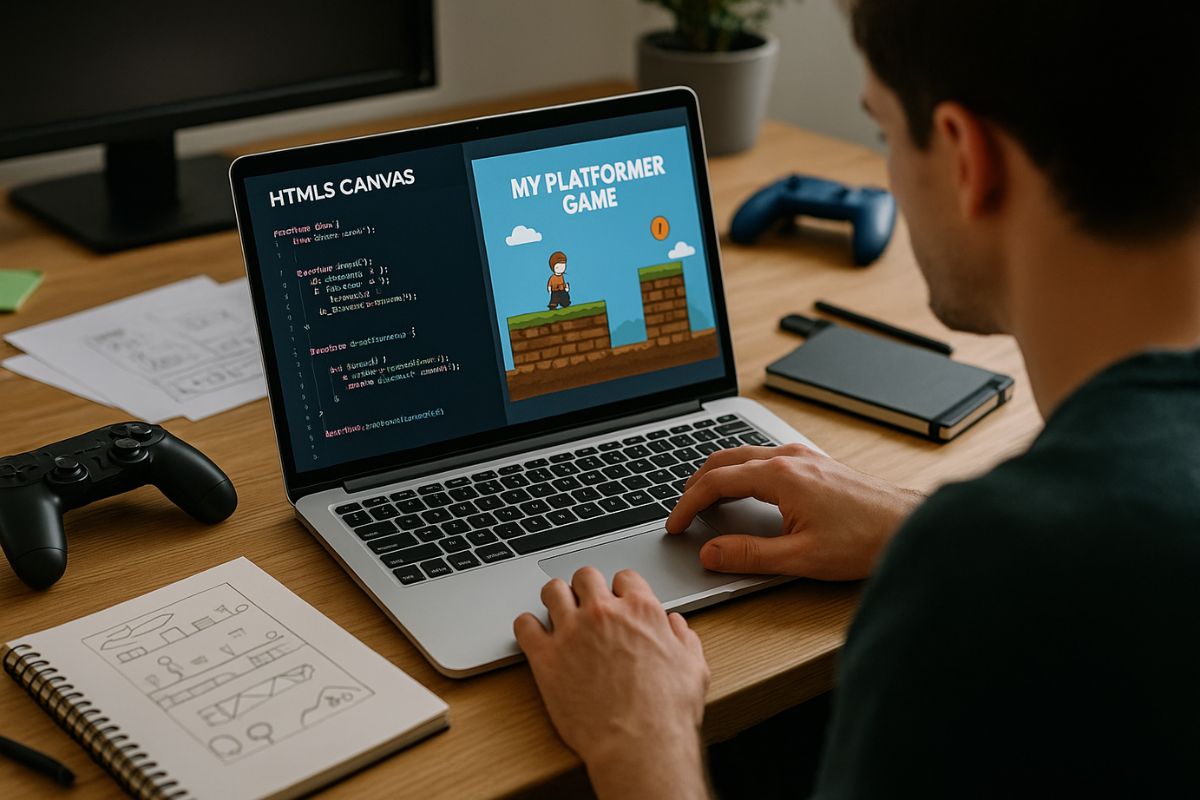Web games have come a long way. Today, thanks to HTML5, developers have access to tools that bring real-time graphics and interactivity directly into the browser. At the center of this transformation is the HTML5 <canvas> element. It’s lightweight, powerful, and fully supported across modern browsers—making it an excellent choice for building 2D games.
Canvas lets developers draw directly to the screen using JavaScript. From sprites and backgrounds to physics and animations, it all happens inside a rectangular area where every pixel is yours to command.
What You’ll Learn in This Article
This article looks at how HTML5 Canvas enables flexible game development. It covers how the canvas works, drawing basics, animation techniques, and practical advice for managing game loops, assets, and user input in a structured way.
Why Canvas Is Still a Solid Choice for Web Games
In a world of WebGL and game engines like Phaser or Unity WebGL builds, canvas may seem like a basic option. But its simplicity is its strength. Canvas offers direct control over rendering, with minimal abstraction. That makes it great for learning, prototyping, and shipping smaller or medium-scope games.
Because it’s just HTML and JavaScript, you don’t need to learn a new engine. There’s no compiling. And it plays nicely with the rest of your web stack—whether you’re building a portfolio, an arcade-style site, or a creative tool.
It’s also efficient. Drawing with canvas is fast, especially when paired with proper optimizations and a smart game loop.
Drawing Basics: Shapes, Colors, and Sprites
Working with canvas starts with setting up the 2D context:
“`javascript
const canvas = document.getElementById(‘gameCanvas’);
const ctx = canvas.getContext(‘2d’);
Once you have the context, you can draw anything—rectangles, circles, lines, and paths. For games, you’ll often load images (sprites), then use drawImage() to place them on the screen.
The real magic comes from redrawing the canvas every frame, clearing it and repainting all the game elements in their new positions. This continuous update is what brings your game to life.
Managing the Game Loop
Every canvas-based game needs a loop. This loop runs around 60 times per second, clearing and redrawing the screen based on player input, collisions, and game state.
You can use requestAnimationFrame() to keep things smooth and efficient:
function gameLoop(timestamp) {
updateGame();
drawGame();
requestAnimationFrame(gameLoop);
}
requestAnimationFrame(gameLoop);
This pattern ensures your game adapts to the frame rate and doesn’t overburden the browser. It also gives you a single place to manage the update-draw cycle, making debugging easier.
Handling Input and Events
Most games involve interaction. With canvas, input doesn’t come built-in—you’ll need to wire it up yourself using standard DOM events.
Listening for keydown, keyup, or mousedown events on the window or canvas element gives you control over how your player moves or interacts. You can track which keys are pressed, calculate mouse coordinates, and even support touch events on mobile.
The beauty of this model is that it’s flexible. You can structure your input logic however you want, separating concerns cleanly across files or components.
Working with Assets: Images and Audio
Loading assets in canvas games is about timing. You need to preload everything before gameplay begins to avoid stuttering or broken visuals.
Images are typically loaded by creating Image objects and waiting for their onload event. For audio, you can use the Audio API or libraries like Howler.js to give you more control.
You can create a simple loading screen while assets are fetched, and start the game once everything is ready. This ensures a smooth experience for the player from the very first frame.
Organizing Game State
As your canvas game grows, managing game state becomes key. Keep your game logic in separate objects or classes. Track player health, position, score, and game level in a central structure.
You might even build a state machine to handle different phases—like start screen, gameplay, pause, and game over. This keeps logic clean and your code easier to extend or refactor.
Even with no frameworks involved, you can bring structure and clarity to your project by thinking ahead.
Performance Tips for Smooth Gameplay
Canvas is fast, but poor structure can make it sluggish. Here are a few habits to keep things moving smoothly:
- Avoid redrawing areas of the canvas that haven’t changed.
- Minimize DOM manipulation inside the game loop.
- Reuse object instances when possible.
- Batch your draw calls, and draw offscreen if needed.
You can also throttle certain expensive calculations to run every few frames instead of every frame. And be sure to test on lower-end devices during development.
Browser Support and Cross-Device Considerations
One of the great things about HTML5 Canvas is its broad support. Any modern browser—desktop or mobile—will render it properly. But each device comes with different performance profiles.
Make sure your game scales to different screen sizes. Consider responsive layout logic or provide fixed aspect ratios and scale the canvas accordingly. This keeps your game looking good whether it’s played on a phone, tablet, or widescreen display.
Accessibility and touch-friendly controls are also worth thinking about. While canvas itself is visual and lacks semantic structure, you can pair it with external controls or overlays for added usability.
Bringing Creativity to Life in the Browser
Canvas gives you a blank slate. There’s no predefined style, no UI widgets, no constraints on how things move or look. This can be daunting—but also freeing.
You can build anything from pixel-perfect platformers to interactive art, casual puzzle games to experimental simulations. If you can imagine it, and you can draw it, you can build it.
And because it’s all JavaScript, you can use the rest of the ecosystem—build tools, type systems, frameworks—to support your project however you see fit.
Canvas doesn’t get in your way. It puts the control in your hands.
Whether you’re just starting or looking to add web-based games to your toolkit, the canvas is a smart place to begin.

No Responses